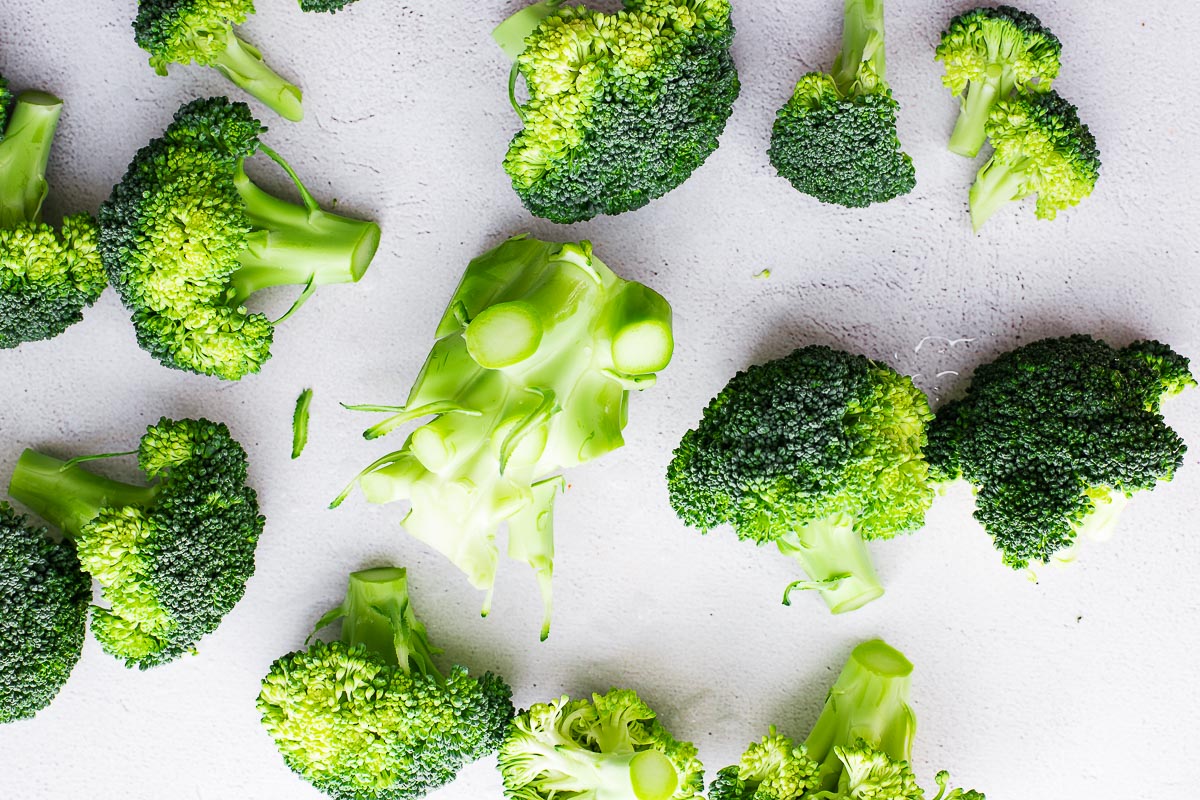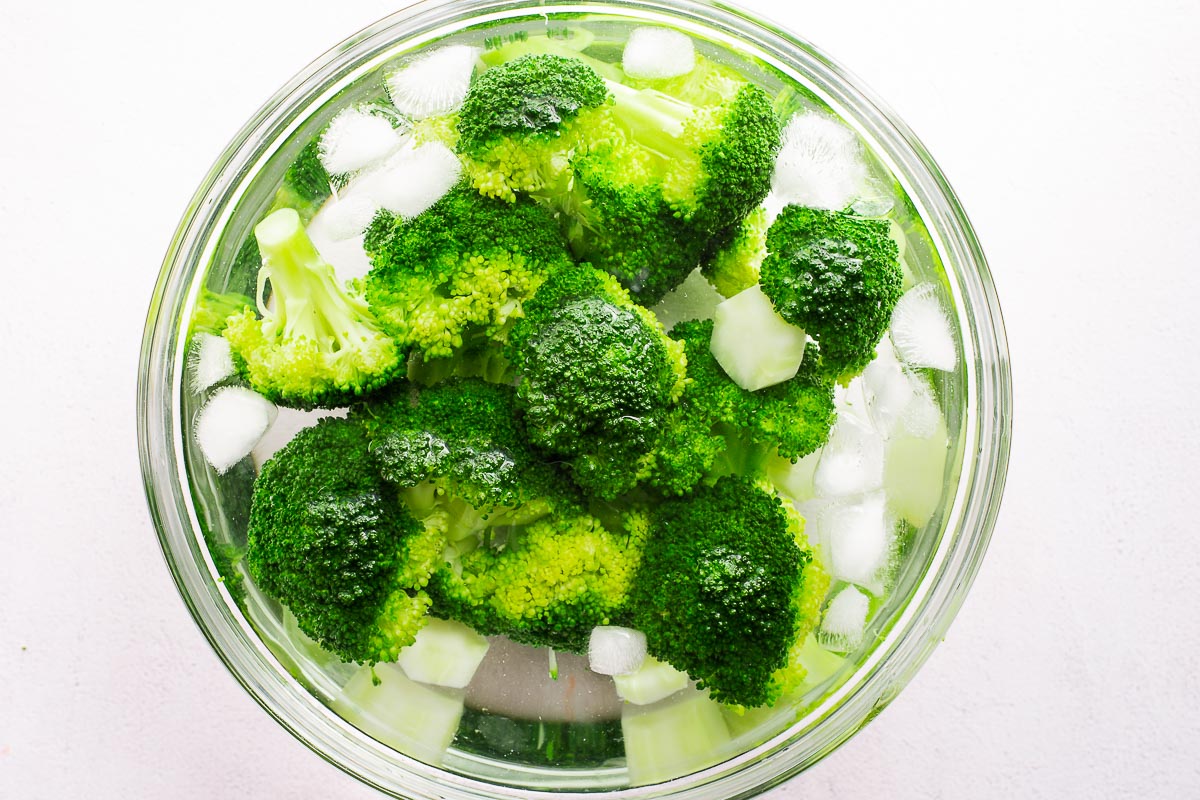How to Freeze Broccoli (The Best Way)
A quick-and-healthy meal is always within reach if you have frozen broccoli in the freezer. Find all the tips and tricks for perfectly blanched and frozen broccoli florets. The freezer is your friend!
Frozen vegetables are a lifesaver in any healthy dinner emergency. And frozen broccoli is right up there.
You can roast broccoli straight from frozen in very high heat with a drizzle of olive oil, salt and pepper. Defrost it and briefly steam or sauté to finish cooking. Or make a quick-and-easy weeknight broccoli soup.
Start with a whole head of broccoli and rinse it well. For roasting, I like to have blanched, whole florets of broccoli. But for soup, I cut the broccoli into small chunks before freezing.
Whatever the plan for your frozen broccoli, I have you covered with step-by-step instructions.

How to freeze broccoli the right way(step-by-step)
While it would be convenient to pop entire broccoli heads straight into the freezer, it requires a few simple steps for the best results.
To freeze broccoli, you need to cut your whole head of broccoli into florets. Blanch the broccoli by rapidly boiling it in water for two to three minutes before plunging the par-cooked florets into an ice bath. Dry the florets well, and flash freeze in a single layer for one hour before transferring it to an airtight container or freezer bag.
Blanching the broccoli preserves the nutritional value and the vibrant green colour. And, flash freezing ensures individually frozen florets instead of a big chunk of broccoli.
1. Prepare the broccoli florets

Rinse your head of broccoli well, and cut broccoli florets from the stalk.
Broccoli stems can be fibrous and tough. So, first, remove and discard the dried-out bottom bit of the broccoli stalk. Then, using a vegetable peeler or a sharp knife, remove the tough outer layers of the broccoli stem. Slice the tender stalk into 1 cm (1/2 inch) chunks.
Smaller broccoli florets work best when you plan to roast or steam your broccoli from frozen. So, half any large florets, trying to maintain even-sized pieces.
2. Blanch broccoli

Bring a large pot of water to a rolling boil over high heat, enough water to comfortably cover the broccoli. Add a tablespoon of salt for each head of broccoli, or omit. Salting the water is optional.
While you wait for the water to reach a rolling boil, get your ice bath ready. Fill a large bowl (large enough to fit all your broccoli) with cold water and ice. Don’t skip the ice bath!
Add the broccoli florets to the pot of rapidly boiling water and cook for two minutes.
Another great way to par-cook the broccoli is with a steamer basket. You can steam the broccoli for two minutes instead of boiling it.
3. Rapidly cool down the broccoli in an ice bath

This essential step creates crisp, bright green broccoli florets.
Remove the broccoli florets with a slotted spoon or strain in a colander. Immediately drop them into the bowl of ice-cold water. Let them cool completely, about five minutes.
Transfer the cold, par-cooked broccoli to a clean kitchen towel and gently pat dry to remove any extra moisture.
4. Flash freeze individual florets in a single layer

Line a baking sheet with parchment paper and arrange the blanched broccoli pieces in a single layer.
Transfer the sheet pan to the freezer until the broccoli florets are frozen solid – about an hour.
I store the parchment paper to reuse for the next batch of frozen vegetables.
5. Transfer the flash-frozen broccoli florets

Now you can transfer your frozen broccoli florets to an airtight container or freezer bag. Freezer bags work best because you can squeeze out as much air as possible to prevent freezer burn.
I wash and reuse my freezer bags for the next batch of frozen vegetables.
Frozen broccoli can keep for up to a year in the freezer. But I prefer to use it within six months before the freezer burn sets in.
Why blanch vegetables before freezing?
While it may seem like a hassle, it is a good idea to blanch broccoli before freezing.
- Blanching washes off any microorganisms that might remain on the surface.
- It partially cooks the broccoli, making the cooking time from frozen faster.
- It slows down the enzyme action that causes loss in flavour, colour, texture and nutrients.
Properly blanched, flash-frozen individual broccoli florets can last up to a year in the freezer. But I try to finish mine within six to eight months before freezer burn can set in.
While we know that blanching extends the freezer life of these vegetables, exactly which parts of vegetable blanching lore are worth the effort? According to a Serious Eats article on the rules of big-pot blanching, the most important is an icy cold bath after the brief boil.
Whether or not to salt the water is optional. To my knowledge, salted water allows fewer minerals to leech out of the vegetables and into the water when boiling. But I also like my vegetables partially seasoned when I take them out of the freezer. You can omit the salt without any risk.
How to freeze fresh broccoli without blanching
You can, of course, skip the blanching process.
However, blanching inhibits the enzymes responsible for colour and nutrient loss. So, you will need to use the frozen broccoli within one month if you skip blanching.
Whenever I return from the grocery store or market with too much broccoli and too little time for the blanching and flash-freezing process, I take the whole head of broccoli and chop it into rough bits and chuck it in a freezer bag. I do the same with celery.
Unblanched frozen broccoli will lose the vibrant green colour, develop ice crystals and lose nutrients much faster than blanched broccoli. And by skipping the flash-freezing process, the pieces will also clump together.
But, this is OK if you use it
- for broccoli soup or another dish where the broccoli gets mashed or blended,
- within one month.
How to use frozen broccoli
Frozen broccoli works best for dishes that require cooked broccoli. Simply defrosting the broccoli for raw salads will lead to soggy results.
You don’t need to thaw frozen broccoli before cooking dishes that require a long cook and can benefit from some moisture, like casseroles, soups, and stews.
Defrost the broccoli florets before you add them to the pan for stir-fries and pasta dishes. Remember to subtract two minutes from the cooking time because the broccoli is par-cooked already.
But, my favourite way to use frozen broccoli for a quick and healthy side dish is to oven-roast or steam it straight from frozen.
See how to cook frozen broccoli for instructions to sauté (or stir-fry), steam or oven-roast frozen broccoli.
Frequently asked questions
Blanching refers to partially cooking vegetables in boiling water (this cooking process can also be called parboiling). After boiling, plunge the vegetables into ice-cold water to stop cooking.
While you can freeze fresh broccoli without blanching, blanching helps preserve its texture, flavour, and vibrant colour. Freezing without blanching will result in a less desirable texture and taste.
The best way to freeze fresh broccoli florets is to first blanch them for two to three minutes, then quickly cool them in ice water. Drain and dry blanched broccoli before spreading them on a baking sheet to freeze them individually before transferring them to a freezer-safe bag.
If you’re freezing fresh broccoli, blanching is recommended. However, if the broccoli is already frozen, there’s no need to blanch it again before cooking.
Blanch broccoli for two to three minutes in boiling water. This brief cooking stops enzyme actions responsible for the loss of flavour, colour, and texture.
Did you know?
You can use this same method to freeze vegetables like Brussels sprouts and green beans. And, you can also freeze diced carrots for soups and stews. See how to freeze carrots.

Equipment
- Large saucepan – for boiling
- Large mixing bowl – for ice bath
Ingredients
- 1 head of broccoli
- 1 tablespoon salt (optional)
Instructions
- Rinse the broccoli, and slice the florets from the stalk. You want small, even-sized pieces, so cut large florets in half.
- Take the remaining chunk of stem and remove and discard the dried-out bit at the bottom. Use a knife to remove the tough outer layers and slice the revealed tender stalk into ½ inch (1 cm) disks.
- Bring a large pot of water to a boil over high heat. Use enough water to submerge all of the broccoli. Add a tablespoon of salt for each head of broccoli (adding salt is optional).
- While you wait for the water to reach a rolling boil, fill a large bowl with cold water and ice.
- Add the broccoli florets and sliced stem to the boiling water and cook for two minutes.
- Drain the broccoli and immediately place the florets in the bowl of ice water. Let them cool completely, about five minutes.
- Transfer the cooled broccoli to a clean kitchen towel and gently pat dry.
- Line a baking sheet with parchment paper and arrange the blanched broccoli pieces in a single layer.
- Place the tray in the freezer and freeze until solid, about an hour.
- Transfer the flash frozen broccoli to an airtight container or freezer bag and return it to the freezer.
Notes
- Store the frozen broccoli for up to a year in the freezer.
- See the step-by-step instructions for more details.
- Also, see how to cook frozen broccoli for inspiring broccoli sides!
More about frozen broccoli
Learn how to cook frozen broccoli by oven-roasting or steaming it straight from frozen. It also includes broccoli seasoning ideas and how to sauté defrosted broccoli florets.
You can also make this broccoli soup with peas and basil using your frozen broccoli. Use them straight from frozen for easy weeknight comfort food.
More broccoli recipes:
